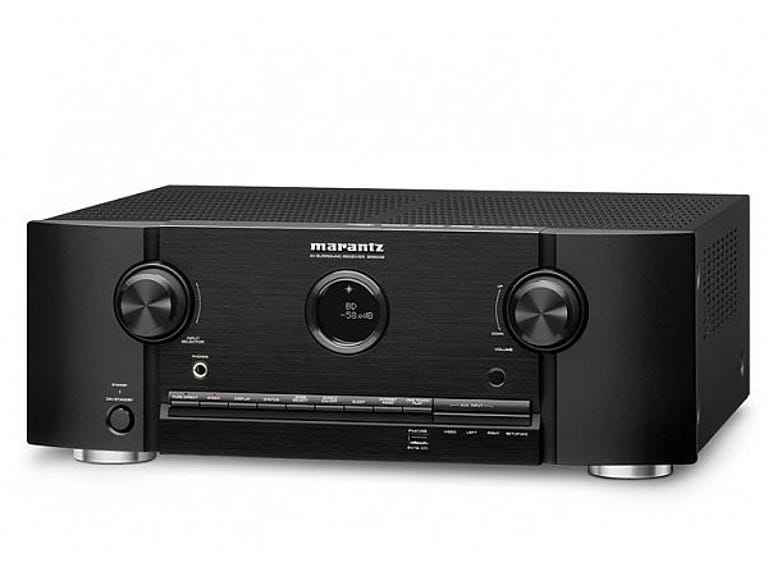 Why You Can Trust CNET
Why You Can Trust CNET Marantz SR5006 review: Marantz SR5006 AV Receiver
At its core, the Marantz SR5006 is a fine home-theatre receiver, but enjoyment of it is sapped somewhat by those poor-quality flickery menus.
The Marantz SR5006 is a home-theatre receiver delivering good audio performance (if you adjust certain settings) and strong new-media support, including AirPlay.
The Good
The Bad
The Bottom Line
Connections
As a lower-level receiver, Marantz has shed this unit's S-Video, but provides six HDMI inputs. None are on the front panel, although there is USB there. Ethernet is provided, along with a sufficient number of older connections, including full 7.1-channel analog audio inputs.
This receiver has a variation on standard connections that we have never seen before. Most receivers either come with just a subwoofer preamplifier output, or with a full set of preamplifier outputs (typically, 7.1 channels). The advantage of the latter is that you can then use the receiver as a surround processor, and connect new power amplifiers to give your system a performance boost. With the former, you're stuck with whatever amplifiers are built in to the unit.
The receiver has two subwoofer pre-amp outputs (same signal to both), plus one pre-amp output each for the left and right front channels. The purpose of these last two? Why, to allow you to use high-power amplifiers, if you choose, for the front stereo pair. Those who are into more exotic stereo loudspeakers could well appreciate this. We do. In our comparison system, for example, we use 300-watt monoblock power amplifiers for the front left and right channels, and the receiver's built-in amps for the rest.
Set-up
Marantz has included a step-by-step set-up wizard in the unit. It's very detailed — more like an installation wizard on a computer — with clear text explanations of what you need to do. It even talks you through connecting cables to each of your loudspeakers, one by one.
When you get to the point of speaker calibration, the receiver employs the Audyssey MultEQ XT system. It can do a simple install with one point of measurement, or one taking greater account of your room acoustics by measuring three different positions. As its name suggests, it provides frequency-response equalisation, as well as the usual speaker size, distance and volume adjustments.
Sound
Sound is delivered by seven 100-watt hi-fi amps. Two of these can be set to drive the surround rear channels, the front height channels (for Dolby Pro Logic IIz) and speakers in a second zone, or to bi-amplify the front speakers. It's quality stuff, and for speakers with prices commensurate with this receiver (ie, aside from some of the weirder exotics), the amps proved to have plenty of power.
However, the receiver initially sounded quite poor. That's because by default it switches on something called "Dynamic EQ", which is an Audyssey-created sound processor designed to improve the sound at low volumes, primarily by boosting certain frequencies.
It simply does not sound right.
The problem isn't that it's on offer, but rather that the Marantz receiver just switches it on without saying anything about it. It's up to you to find the menu setting to switch it off (Audio Adjust > Audyssey Settings > Dynamic EQ).
That done, this is a fine-sounding unit. It also defaulted to providing stereo sound from stereo sources, rather than some weird "All Channel Stereo".
Video
This receiver converts analog video inputs to HDMI, but the quality is pretty poor for SD signals. HDMI video is passed through without any form of conversion or scaling, which keeps things simple and clean.
The unit can overlay its functional, but cleanly rendered, menus over whatever source video is showing, except for 3D. But, in the absence of some underlying signal, the unit defaults back to 576p, and this is clearly based on a 576i (interlaced) graphic generator, which is converted to 576p fairly poorly, leading to the flickering of menu items slightly up and down on the screen.
The front panel display is a small circular one with very little information, so you rely a great deal on the onscreen display.
iOS devices
The USB front panel display, surprisingly, supported not just MP3 and WMA, but also FLAC. Even more surprisingly, it supported JPEG photo display. But you won't want to use it; the display engine only worked at 576p, and messed up the pictures' aspect ratios, so no pleasure could be derived from looking at them.
You can plug an iDevice into the USB socket using a standard iPod/USB cable, and play its music (and display album art) using the OSD and the remote control.
The best way to interact with the unit with your iPhone/iPad/iPod Touch is to use Apple AirPlay, which is built in to the receiver. Play the iPod app on your device and choose "marantz[sr5006]" from the drop-down speaker list, and AirPlay will take over the receiver, play the iPod music and show cover art (if any). We love this feature — the sheer convenience is almost enough to make one eschew CDs and other uncompressed sources.
Internet content includes thousands of internet radio stations provided by vTuner, Napster and Flickr. You won't want to use the last; low-resolution images in the wrong aspect ratio do not impress.
The DLNA support is good with music, and lousy with photos for the same reasons.
For all of this network stuff, plus USB and directly connected iPods, navigation through lists is good. A "Search" key allows you to jump pages at a time, and search for any initial letter.
Overall
At its core, the Marantz SR5006 is a fine home-theatre receiver, but enjoyment of it is sapped somewhat by those poor-quality flickery menus.


